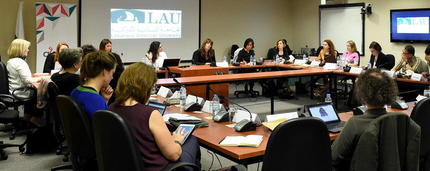Refugee contribution through history, focus of LAU conference
International researchers gather for a three-day conference that counters the current negative narrative of the global refugee crisis.

Participants engaged in highly interactive sessions that attracted civil society actors and representatives of international organizations.
More than 20 scholars from no less than a dozen academic institutions in the Arab world, Europe and North America gathered at LAU Byblos last week to tackle the issue of refugee transfers through and around the Mediterranean through in recent and historical times.
Referring to the mass movement of refugees in recent years, Assistant Professor of Political Science and International Affairs and co-organizer of the conference Tamirace Fakhoury introduced the three-day conference, hosted in collaboration with Germany’s University of Heidelberg, as one that seeks to highlight the role of refugees as contributors to their host countries, and to counter the dark predominant narrative of a refugee crisis.
“This is a global governance crisis,” said Fakhoury, member of the Arab-German Young Academy of Sciences and Humanities (AGYA), the sponsors of the conference. “Forced migration flows are not a new phenomenon, but they have brought [policy] gaps into stark relief.”
On hand to welcome the speakers and guests was Assistant Provost Wassim Shahin, whose own research in the field of economics also tackles migration. “Our university’s new strategic plan includes as one of its pillars the concept of LAU without borders. What better signifies this important focus than this conference.”
The body of international scholars in attendance presented papers on refugee contributions to the production of new narratives, the circulation of new norms and revival of cities, throughout the ages.
In addition to present-day experiences of Syrians in Turkey and Europe, topics addressed in some of the presentations included mass migration in the Middle Ages, deportation in the ancient Near East, and peril and protection in the Medieval Mediterranean. Explaining the trans-historical approach of the conference, co-organizer Jenny Oesterle of Heidelberg University said: “In current debates on migration and asylum, Arab countries are only considered as regions that produce refugees. But for centuries, Islamic countries developed their own form of refugee asylum.”
Oesterle’s own presentation focused on the migration of the Prophet Mohamed’s Muslim companions to the Christian region of Abyssinia, modern-day Ethiopia. “It is an example of two monotheistic religious states at different stages of development [co-existing] without antagonistic relations,” said the scholar, highlighting the learning opportunity for modern-day host nations.
By contrast, the presentation of Nicholas Terpestra, chair in the Department of History at the University of Toronto, highlighted how Jewish migrants – 80,000 of whom were expelled by the Spaniards in 1492 – were denied settlement in Italy before moving to the coastal towns of the Ottoman Empire. “The self-image of the empire was that it was one that absorbed others,” said Terpestra, adding that the exile of Jews from Spain was but one of four large scale migrations that gripped the region for the next 150 years.
Dawn Chatty, professor of anthropology at the University of Oxford, also focused on the Ottoman Empire in her presentation, contextualizing the Syrian state as refuge for forced migrants. Refugees there in 19th century were given land and temporarily exempted from taxes and conscription. “The Ottomans produced the first refugee code, in 1857… which focused not only on how to integrate people but also how to help them in times of crises.”
LAU Assistant Professor of Political Science Jennifer Skulte-Ouaiss was also among the contributors, presenting her research into the relationship between perceived insecurity and the mapping of ideological, emotional and physical borders.
“It’s been fascinating to hear about different refugee populations through the ages and learn about their struggles and circumstances,” said one of her students Marwa Alkatheery, who also engaged in the final session of the conference that saw scholars and students cluster into groups.
The interactive session attracted civil society actors and representatives of international organizations and took the form of a brainstorming session during which each group prepared a brief presentation of recommendations on the political, social or cultural and economic policies affecting refugee populations in Lebanon. Among those summarizing the conclusions of group discussions was LAU student Christine Al Jour. “There appears to be a disconnect between humanitarian and political thought, with some expecting the UN to support Lebanon as a host country and others believing it to be the government’s role.”
Each group intervention was an opportunity for active dialogue and learning about topics that are timely and relevant to the student body. The entire conference, explained Fakhoury, “is a pivotal event that reflects LAU’s research vision as one informed by the region’s priorities and policy challenges.”
The contributions and findings of the conference will culminate in a publication that will benefit from the support of the AGYA and the German Ministry of Education and Research.
More
Latest Stories
- Into the Psychology of Justice
- Alumnus Zak Kassas on Navigation, Spoofing and the Future of GPS
- Hearing Between the Lines
- LAU Hematology Conference 2025: Advancing Science Through Interdisciplinary Exchange
- Dr. Chaouki T. Abdallah Invested as LAU’s 10th President
- LAU Guides Its Students Through the Code of Conduct
- Innovative Procedure at LAU Medical Center–Rizk Hospital Signals Hope for a Patient With a Congenital Disease
- LAU’s Inaugural PodChat Session Addresses AI Detection in the Classroom

